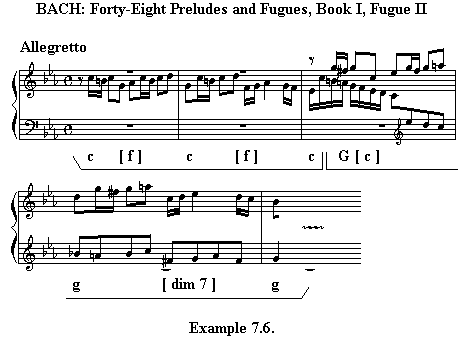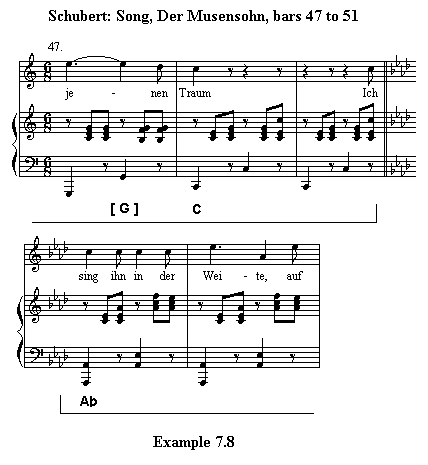
CHAPTER 7 (PART 3)
MODULATION
Tonic to Tonic Modulation
By far the most common type of modulation is modulation during dynamic harmony as indicated in the last two sections. However, composers occasionally modulate by juxtaposing two keys directly next to each other. This can be by two static harmony elements in different keys joined to form one static harmony element or can be one phrase following another directly in a different key without any dynamic harmony to facilitate the modulation.. The first has its origins in the contrapuntal writing of fugue. In the following fugal example, the need to bring the second voice in at the dominant pitch requires that the initial C minor static harmony be repeated one fifth higher with no intervening dynamic harmony. Thus two static elements are immediately juxtaposed in different keys forming a single static syntactic element. The falling 4th progression from the C minor chord to the G major chord is too weak to be interpreted as dynamic harmony.

When analysing examples of contrapuntal writing, as here, some interpretation is required to determine what harmony is implied by the single or two part writing. The interpretation can often be tested by making a comparison with a similar passage elsewhere in the piece with fuller part writing. For instance, the interpretation of the third beat as chord IV is supported by the fuller harmonisation later in bar 7. However, whether this beat should be interpreted as auxiliary chord IV or some other auxiliary chord or just plain auxiliary notes does not make any difference. Whatever the implied harmony is, bars 1 - 2 are a static prolongation of the C minor tonic chord.
Since the second voice enters with the answer to the fugal subject one fifth higher, static harmony on G starts immediately. At bar 5, the first fugal 'episode' starts. This is a rising sequence based on dynamic harmony using α and β progressions.
Following is an example of modulation, 'tonic to tonic' in a non-contrapuntal context:

Here the end of one phrase in C major is immediately followed by a new phrase in the unrelated key of A-flat with no intervening dynamic harmony. The only connection is the common note C.
The full book will contain a further example from Brahms of modulation within static harmony in a non-contrapuntal context.

